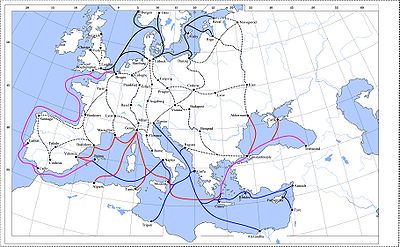WHI-Chap20-Obj2
| Between the 9th and 14th centuries, the European population rose from twenty nine to seventy nine million. With the new numbers of people, it was possible to have large urban communities, and a new class of artisans and craftsman emerged. This new labor force expanded the manufacturing of goods, which raised the volume of traded goods in Europe. |  [1] [1] |
Mediterranean Trade
During the tenth century, cities like Venice acted as ports to the eastern Mediterranean, even with Byzantine and Muslim traders. Italy played a major role in Mediterranean trade because of its position, and opened many port cities such as Genoa, Naples, and Pisa. Italy even traded with partners as far as India, southeast Asia, and China. Over time, Italians formed small colonies of people in other ports around the Mediterranean and black seas, Venetian and Genoese communities could be found in Constantinople, Alexandria, Cairo, Caffa, and Trebizond.
The Hanseatic League
Although the most active trade was in the Mediterranean, the North and Baltic Seas also received a fair amount of trade. The Hanseatic League (or Hansa) was a group of trade cities from Novgorod in modern Russia to London England. Significant commercial centers of Poland, northern Germany, and Scandinavia where also part of Hansa. The Hanseatic League traded grain, fish, furs, and timber in high quantities, dominating the northern European trade market. Rivers like the Rhine and Dnieper linked the Hansa and Mediterranean trade networks.
Also See:
References
- Traditions and Encounters
This page was written by: William Breckwoldt